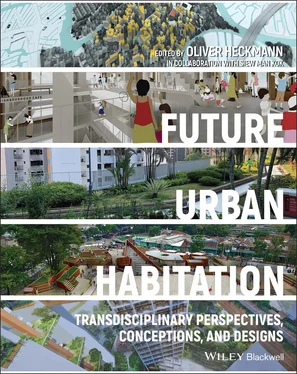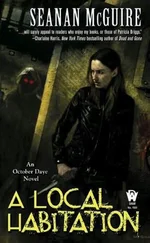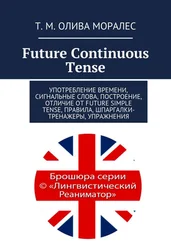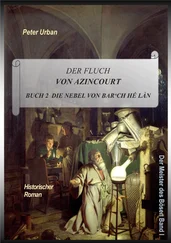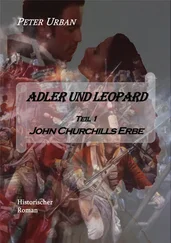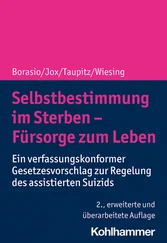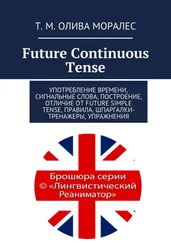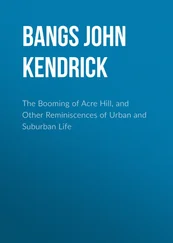1 Cover
2 Title Page Future Urban Habitation Transdisciplinary Perspectives, Conceptions, and Designs Edited by Oliver Heckmann
3 Copyright Page
4 List of Contributors
5 Introduction Inclusive Urbanism High‐Dense Typologies for Building Communities Adaptive and Responsive Habitation New Tools, New Approaches References
6 Section 1: Inclusive Urbanism Introduction Inclusive Design Exclusion Agencies of Inclusion Designing Coexistence References 1 Towards a New Social Model of the City: Barcelona’s Integral Superblocks The Care Challenge in Barcelona During Uncertain Times Care for the Elderly and Dependent Population Innovative Practices: Milestones Towards a New Approach to Care On the Horizon: A New Social Model for the City Organized into Integrated Superblocks? References 2 Link by Link: Blurring the Lines and Creating an Inclusive Society in Singapore A City's Relational Opportunities Long Bridges Make Inclusivity Possible Strategies for Inclusion Conclusion References 3 Inclusive Smart Community ‐ Towards a Socially Integrated and Enabling Community Introduction Social Integration Enabling Community Inclusive Smart Community Acknowledgement References 4 Designing for Depopulating Conditions ‐ Formulating a Strategic Neighbourhood Framework for Detroit Grand River Northwest Neighbourhood Framework Plan Russell Woods + Nardin Park Neighbourhood Framework Plan Conclusion 5 Multi‐Programmatic Urbanity for Indonesia The Indonesian Context and Challenges for Public Space Architect as Stakeholder: Designing and Communicating in‐between Uncertainties Taman Film, Alun‐Alun Cicendo and Microlibraries: Unpredictable Processes, Participation, Collaboration Exploring ‘Kampung Vertikal’ Idea: Inclusive Urbanism with Multi‐Programmatic Spaces Vertical Communalities with Multifunctional Spaces: Muara Angke Fishing Village and Public Balcony Housing 6 Affordable Housing and Social Inclusion ‐ The Case of Vienna and Austria Introduction The Commodification of Housing and its Impacts on Housing Inclusion Housing Governance and Inclusion: The Role and Governance of Limited‐Profit Housing Associations in Austria and Vienna Cost‐Rent and Revolving Funds: Affordable Housing as an Accounting Practice For‐Profit vs Limited‐Profit Housing: Affordability and Inclusion Conclusion: From Shareholder Value to Public Value References
7 Section 2: High-Dense Typologies For Building Communities Introduction Forms of Togetherness The Roles of Spaces Spaces – Hierarchies or Integrities Provision Negotiation Note about the Figures References 7 Fostering Community Bonding in High‐Density Habitations Introduction Theoretical Framing and Design Strategies to Foster Community Bonding Case Studies of High‐Density Habitations in Three Asian Cities 1 Conclusion Acknowledgements References 8 HDB: High‐Density Typologies for Building Community Evolution of Community Spaces Community Spaces in HDB Towns Space for Future Needs Landscaping and Greenery Types of Facilities Renewal of Existing Estates Survey Findings New Typologies for Community Bonding The Pinnacle@Duxton SkyVille @ Dawson Kampung Admiralty Other Efforts to Engage the Community Future Directions – Tengah 9 Building Communities in High‐Density Singapore ‐ a look at Integrated Design Typology Introduction What Is an Integrated Design Typology? A Future Model: A Symbiotic Development Approach Future Proofing: Enable Flexibility and Adaptability Future System: Embrace New Technologies Conclusion Celebrating the Public Realm in the City An Urban Oasis in the City Changing the Paradigm in the Use of the Ground Floor Urban Park as a Gathering Space Multi‐Level Connectivity A Clear Hierachy of Public and Private Space A New Urban Design Typology Integrating Housing with Age in Place Facilities Acknowledgements Reference 10 Making Sense of ‘Community’ ‐ A Call for New Kinds of Knowledge to Shape Urban Futures Urban Policy and the Re‐invention of ‘Sustainable Communities’ Making Sense of Community in Practice Understanding the Value of Shared Space in London Conclusion: Making Sense of ‘Community’ in New Ways References
8 Section 3: Adaptive and Responsive Habitation Introduction Shifting Demographics Gentrification Work‐Life Balances Adaptability and Its Agency Adaptive and Responsive Operational Forms in Housing Relational Practices in Built Environments Agency Note about the Figures References 11 Alternative Housing for a Diverse and Inclusive Society An Evolving Society Alternative Housing Proposals Housing Diversity and Building Solidarity Are Sustainable Approaches References 12 Type‐Figurations ‐ Comfort Zones and Active Grounds Premises Revisit One Revisit Two Conclusion 13 Promoting Healthy Longevity – The Role of Social Innovation The World Is Growing Older The Rise of One‐Person Households Entrepreneurship Mentoring Programmes Designers and Social Innovation References 14 Experiments in Living Together Introduction Mid‐Sized Challenges: Winnipeg, Manitoba, Canada Our Approach Conclusion 15 Beyond the Unit – Future Hybrid High‐Rise Commune Introduction Structure Paradigms of Confinements Alternative Models Future Hybrid High‐Rise Commune Conditions for Vertical Communality Tools for Future Urban Habitation Conclusion Acknowledgements References
9 Section 4: New Tools, New Approaches Introduction What is the Question? Environmental Sustainability Social Sustainability Conclusion References 16 Toolkits for Renewable and Regenerative Buildings Decarbonisation of Buildings Renewable Materials Flexibility and Adaptability Computational Tools and Digital Technologies Conclusion Acknowledgements References 17 Social Design – Principles and Practices to Foster Caring Urban Communities Introduction Social Design, Designers and the Social La Borda Story – From Convivial Practices to Caring Cities Who Cares? Story – Nurturing an Urban Ecosystem of Caregiving Hospitable Hospice Story – A Community‐Based Model for End‐of‐Life Care The Importance of Re‐centring Care in the Urban Design Strategy The Relational Dimension of Services in Cities Service Design Tools to Build the Relational Dimension of Future Urban Habitation Conclusions References 18 Computational Design Futures in Housing Refining Site Planning Feedback Between Unit and Site Plans Integration Within an Existing Dense Urban Fabric Conclusion References 19 Retooling Architectural Performance Analysis Sustainable Design Process Computational Design Tools Expanding Further into the Urban Scale of Habitation Outlook Conclusion References
10 Index
11 End User License Agreement
1 Chapter 2 Table 2.1 Network diversity scores based on IQV measures. Table 2.2 Combinations of housing dyads. Table 2.3 Combinations of schooling status dyads.
2 Chapter 10Table 10.1 Understanding prosperity in context – principles for citizen‐led...Table 10.2 Ten factors most important to prosperity.
1 Chapter 1 Figure 1.1 Density of SAD's users and locations in the District of Ciutat Ve... Figure 1.2 Provisional map of SAD superblocks, Barcelona 2019. Figure 1.3 Density of SAD's users and location of the proximity SAD pilot pr...
2 Chapter 3 Figure 3.1 Kebun Baru Bird‐singing Club at Ang Mo Kio. Figure 3.2 The pet bird shop run by the community leader of Kebun Baru Bird‐... Figure 3.3 Rooftop community farm appropriated from multi‐storey carpark roo... Figure 3.4 Factors that contribute towards creative place‐making and place‐k... Figure 3.5 Blending of Big Data and Thick Data in urban design and planning.... Figure 3.6 Data collected through place‐based sensors including motion senso... Figure 3.7 Data collected through field observations at selected points of i... Figure 3.8 Frequency analysis on the choice of most important public spaces ... Figure 3.9 Frequency analysis of reasons for choosing most important public ... Figure 3.10 Neighbourhood public space framework. Figure 3.11 Co‐learning and co‐creating generative place‐making process. Figure 3.12 Design proposals by students in consultation with residents thro... Figure 3.13 (Top) Initial design variations; (Middle) Co‐creating with resid... Figure 3.14 The overall environment of existing void deck was also improved,... Figure 3.15 Proposed Community Enablement Framework, integrating offline wit... Figure 3.16 New Urban Kampung Research Programme, in collaboration with HDB ... Figure 3.17 Different physical co‐creation approaches adopted in different t... Figure 3.18 Online platform ‘nukampung’ aims to serve as a digital community...
Читать дальше
